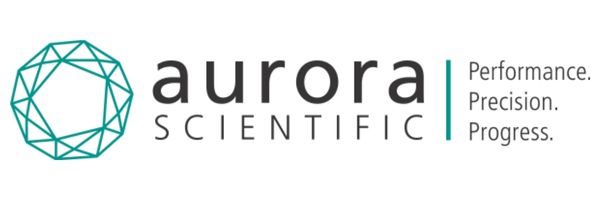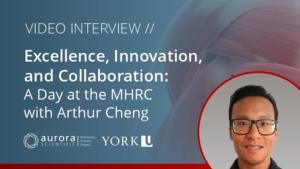Excellence, Innovation, and Collaboration: Key Research at the MHRC
For the past 30 years, Aurora Scientific’s instrumentation has been a cornerstone in many laboratories that are advancing muscle physiology research. This past April, we partnered with InsideScientific and the Muscle Health Research Centre (MHRC) at York University, a one-of-a-kind facility that fosters an interdisciplinary approach to the study of muscle physiology. We had the privilege of interviewing a number of faculty and students to highlight their research, as well as the opportunities provided to them by the MHRC.
While fundamental to our everyday lives, skeletal muscle is often an underrepresented area of research compared to other tissues and organs. We interviewed three keystone researchers who are shaping the future of skeletal muscle health: David Hood, PhD, Peter Backx, PhD, and Ali Abdul-Sater, PhD.
Moving beyond skeletal muscle
Dr. David Hood, the Director and Founder of the MHRC, first took us through the organization’s history. In 2002, the MHRC started out as an idea among several researchers who were interested in advancing research into skeletal muscle physiology. Over the years, the idea of a dedicated skeletal muscle research center continued to grow; in 2009, the facility was officially founded after a formal application was approved by York University.
Since then, the MHRC has expanded immensely, with 25 faculty members and more than 120 trainees now investigating all avenues of muscle health. While their original purpose was to study the fundamentals of skeletal muscle, the breadth of research has grown considerably, studying mechanisms from cellular to whole body levels.
“Our first concept on muscle health was pretty narrow, but [the] great talent that we’ve acquired here over the years … has allowed us to expand our interests and our breadth.”
In addition to fostering late-breaking research, the MHRC has grown to aid both students and faculty in professional development, which Dr. Hood has witnessed firsthand. The MHRC offers fellowships for graduate students to help defray the cost of their tuition, and also boasts an active and impactful student committee that organizes seminars and professional development events such as career days. Additionally, the facility helps faculty in securing collaborative research grants to support new research endeavors and improve infrastructure and technology. The MHRC also runs an annual muscle health awareness conference, which brings in roughly 160 muscle physiology researchers from across the globe.
“[Our goal] is to be Canada’s leading institution for research, education, and training in muscle health.”
Arrhythmias affecting endurance athletes
We also had a chance to speak with Dr. Peter Backx, an expert in cardiac mechanics and heart failure who is studying how arrhythmias affect skeletal muscle. Recently, Dr. Backx has become interested in how exercise can both mediate and cause cardiovascular disease. He notes that endurance athletes (e.g., soccer and hockey players) can develop atrial fibrillation similarly to individuals with obesity and diabetes. Dr. Backx also shares that he was diagnosed with atrial fibrillation after spending much of his youth playing soccer, further fueling his interest in this area.
“[Our team is] trying to understand [how] dose dependence and the type of exercise … impacts the heart.”
Dr. Backx employs several different exercise regimes (e.g., forced exercise, treadmill running, swim training, voluntary free wheel running) to induce atrial fibrillation in mice. To characterize the resulting changes in cardiovascular function, his students perform Langendorff procedures to isolate cardiomyocytes, measure contraction, and analyze how different currents can impact arrhythmogenesis. Through genetic manipulation, his team can determine which cells exhibit the biochemical pattern that is responsible for these cardiac changes.
Mediating inflammation with exercise
Lastly, we spoke with Dr. Ali Abdul-Sater, who holds the Research Chair in the Regulatory Mechanisms of Inflammation at York University. He primarily researches how to control and balance inflammation, as well as how exercise can mediate this bodily response. Dr. Abdul-Sater investigates the cellular mechanisms of inflammation in both humans and animals, and observes changes in signaling pathways using techniques such as flow cytometry.
Additionally, Dr. Abdul-Sater frequently collaborates with Dr. Chris Perry at the MHRC, who we interviewed earlier in this series. Collaborations like these facilitate an interdisciplinary approach for characterizing skeletal muscle health. To conclude this interview, Dr. Abdul-Sater also highlights the many opportunities available to students at the MHRC, including professional development events and scholarships.
While this blog post highlights some of the labs and facilities available at the MHRC, there are many other fascinating projects led by scientists who are shaping the future of muscle physiology research. Check out our previous blog posts to learn more about research opportunities at the MHRC!
Explore Interviews, Webinars, & More!
We summarize interviews with a number of students to highlight their research and the opportunities provided to them by the MHRC.
Interviewing Dr. Arthur Cheng at the MHRC, whose lab investigates mechanisms of skeletal muscle weakness and fatigue.
Interviewing Dr. Christopher Perry at the MHRC, whose lab studies metabolic dysregulation in murine models of muscle weakness disorders.






